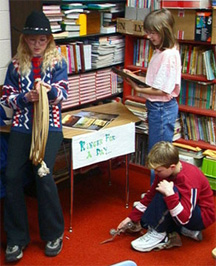
|
|
|
Activities
|
Extensions
|
|
|
|
Background
|
Related
Links
|
Activity
Title: 'Ringer for a Day'
Subject
Area: Math
Grade
Levels: 5th + 6th
|
Using
addition and/or multiplication skills, students will apply
prior knowledge of math applications to solve a math situation
in cattle management.
Practical
application of this math problem can be a whole class lesson
or incorporated into one of several classroom stations. As
a group activity, students may work ingroups of two-five members.
It is recommended to comprise each group of a range of abilities
and learning levels.
Close
monitoring of these groups keeps a balance within the group
participation so that one student is notdominate in completing
the work at the station while others are uninvolved.
|
 |
Each
member is required to document work completed in their journals
with feedback and calculations. The groups are given twenty minutes
per station to complete their research and work before moving on
to the next station.
Materials:
- Examples/pictures
of mustering (gathering) cattle on a large cattle station
- Journals/pencils
for computation process
- Supplementary
materials: Website resources/click for video footage.
|
Background
and Procedure:
Your
job is to hire a crew to muster a large paddock (gather cattle
from a large pasture). Not only is efficiency important, but
you must complete the work in the most economical way possible.
The paddock is 300 square kilometres, extremely rocky, and
the cattle are scattered throughout. The options are to hire
seven ringers (drovers) on horseback, or to hire a heli-mustering
company using single pilot helicopters. Which do you think
would be the most economical? Let’s take a look…
|
 |
A ringer gets $100/day so a crew of nine would cost a station $900\day
to employ. Cost of food for the crew, fuel for vehicles and assorted
expenses can run an additional $100/day. Total: Cow camp costs:
$1000\day. Due to the paddock’s size and rockiness, it will
take approximately one week for the ringers to muster it. Total
cost to complete the muster: $7000.
To
hire one helicopter to muster the paddock would cost a station $240/hour.
This includes the use and maintenance of the helicopter and pilot’s
fee of $60/hour. Helicopter fuel is another expense at $60/hour.
Total: $300/hour. For a ten-hour day of work, one helicopter would
cost $3000. Due to the quickness of travel and the ease with which
a helicopter can move about the paddock, mustering time is considerably
reduced as horses would have to negotiate the rough terrain, which
would take longer to muster?
As
a cattle station manager, which do you think would be the most efficient
way to complete the mustering?
Analyze
and Conclude:
- Compare
the costs of the mustering techniques, predicting the length of
time each would take to muster the paddock.
- Analyse
your costs for each and select the most efficient way to complete
this job. (Hint: two helicopters mustered this pasture in five
hours).
- What
would be the total costs involved and which is the most economical
way to complete this job?
Lesson
Extensions:
Students
may create a heli-mustering company.
- Research
costs to assemble a fleet of three/four single pilot helicopters,
fuel, pilot costs, etc.
- Brainstorm
ideas within the group as to supplies needed for your company.
- Compute
hourly costs for hire by local cattle stations for mustering jobs.
(Remember to plan yearly as work during the ‘dry’ season
is at a premium, whereas ‘wet’ season work is minimal
at best due to adverse weather conditions).
|
